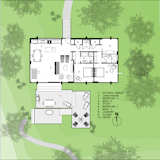5 more photos
Details
Credits
From Anthony Weber
Camp Double Oak is a masterfully designed retreat nestled in the heart of the Pocono Mountains, just two hours from both Manhattan and Philadelphia. This serene haven is strategically positioned to capture the breathtaking natural beauty of its surroundings. To the south, a sweeping vista unfolds along the lake’s pristine shoreline, untouched by signs of development, offering an uninterrupted panorama of water and sky. To the north, an estuary feeds into the lake, its marshland adorned with tall, windswept grasses that sway rhythmically, giving way to winding tributaries that meander gracefully into the water’s expanse.
Designing this home presented extraordinary challenges, demanding innovation, adaptability, and meticulous execution. The steep, irregularly wooded site required creative architectural solutions to integrate the structure harmoniously into the landscape while minimizing environmental impact. The remote location compounded these difficulties, necessitating precise logistical planning for the transport of materials and skilled labor.
The architectural design is a harmonious fusion of early and mid-20th-century modernist influences, seamlessly blending timeless elegance with contemporary functionality. Drawing inspiration from icons like Mies van der Rohe’s Farnsworth House, with its ethereal floating planes suspended delicately between earth and sky, the vision embraces an architectural lightness. Le Corbusier’s Villa Savoye, poised gracefully on pilotis as an “object in nature,” and Pierre Koenig’s Case Study House for the Stahl Residence, celebrated for its horizontal planes framing sweeping Los Angeles vistas, further shaped the home’s aesthetic narrative.
Rooted in modernist principles, Camp Double Oak celebrates simplicity, functionality, and the authentic expression of materials, subtly refined by Renaissance ideals of harmony and proportion to achieve effortless integration into the natural environment. Its clean lines and expansive open spaces cultivate a sense of clarity and airiness, accentuating the beauty of minimalism while honoring the rich landscape it inhabits.
At the heart of the design is a commitment to environmental synergy. Energy-efficient radiant floor heating complements expansive glass surfaces, allowing natural light to flood the interiors and reinforcing a profound connection to the outdoors—an embodiment of biophilic design. The exterior is clad in charred wood, a contemporary nod to the traditional Japanese technique of shou sugi ban, historically valued for its durability and natural wood-preserving qualities. Its rich, blackened texture—reminiscent of aged whiskey barrels and the rugged bark of ancient oaks—harmonizes beautifully with the forested surroundings, evolving gracefully through the changing seasons. This material extends indoors, dissolving the boundary between inside and out, enhancing the immersive connection to nature.
Inside, the architecture strikes a balance between modern simplicity and inviting warmth. A timeless palette of rich walnut wood, striking black-and-white Calacatta marble, and sleek porcelain tiles weaves through the living spaces, fostering a cohesive, elegant aesthetic. Full-height sliding pocket walls offer flexible spatial arrangements, while floor-to-ceiling glass and imported tilt-and-turn window walls blur the lines between the built environment and the natural world beyond.
Understated modernist furnishings complement the architectural language, enhancing the serene ambiance and reinforcing the home’s dialogue with its surroundings. Every detail, from the materials to the spatial flow, is meticulously crafted, reflecting both aesthetic sophistication and environmental consciousness.
Achieving European PassiveHaus standards introduced unique challenges, particularly in relation to thermal comfort, airtightness, and energy efficiency. Limited access to specialized local craftsmanship heightened these complexities. A key accomplishment was the sourcing and installation of triple-glazed insulated windows imported from Germany. Each towering 10-foot unit, some weighing up to 2,000 pounds, demanded the expertise of skyscraper window installers from Manhattan. Installed entirely by hand, these monumental glass panels are a testament to the precision, collaboration, and dedication required to bring this visionary home to life within its challenging natural setting.
Camp Double Oak is not just a residence; it is an immersive experience—where architecture, landscape, and sustainable innovation converge to create a sanctuary that honors both modernist ideals and the untamed beauty of the Pocono wilderness.



















